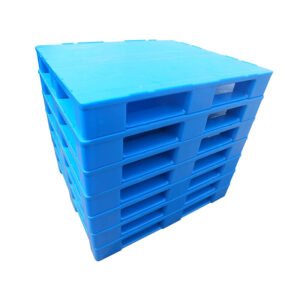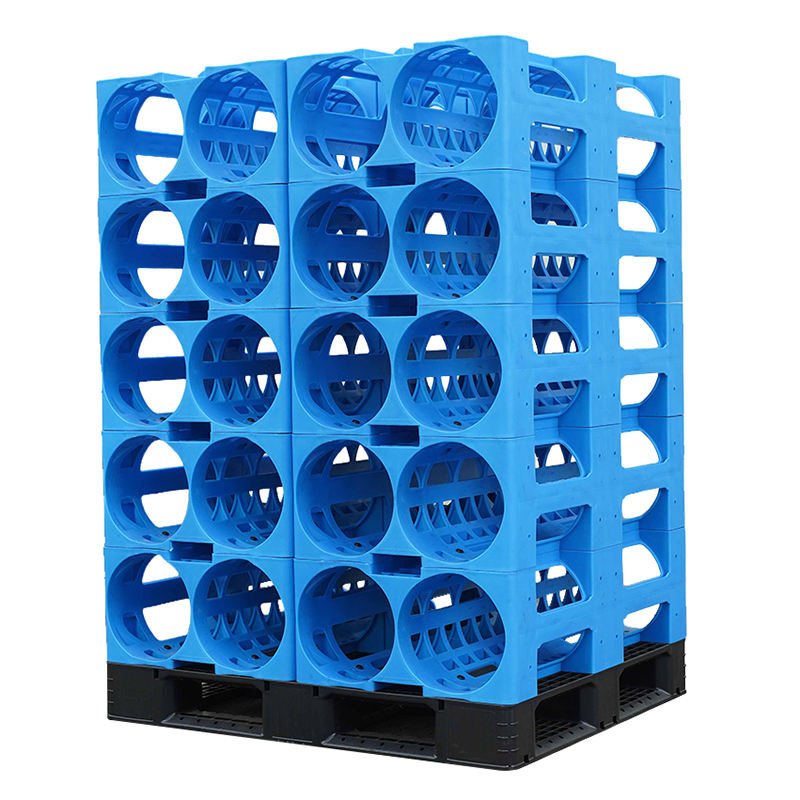Introduction: The Critical Role of Spill Containment Pallets in Industrial and Environmental Safety
In the industrial realm, where the handling of hazardous materials is a daily reality, the importance of effective spill management cannot be overstressed. Spill containment pallets, particularly those designed with bunded secondary containment, serve as a crucial line of defense, safeguarding workplaces and the environment from potential contamination and damage. These containment solutions are specifically engineered to capture spills, leaks, or drips from containers, drums, and tanks, preventing hazardous substances from escaping into the environment.
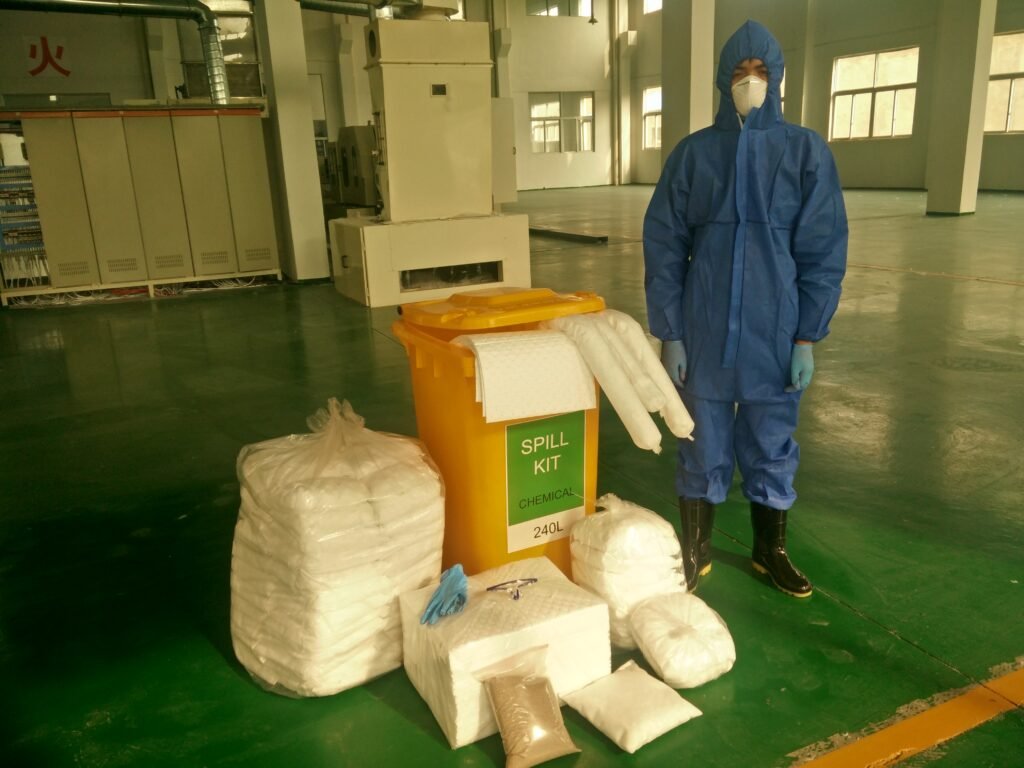
The significance of these pallets extends beyond mere regulatory compliance; they embody a proactive approach to environmental stewardship and workplace safety. By containing spills at their source, these pallets mitigate the risks associated with the accidental release of chemicals, oils, and other potentially dangerous substances. This not only protects the natural ecosystem from pollution but also minimizes the risk of fire, explosion, and health hazards that can arise from uncontrolled spills.
Moreover, the impact of spills on businesses can be profound, encompassing legal penalties, cleanup costs, and damage to reputation. In this context, the role of spill containment pallets in spill management and prevention becomes evident. They enable organizations to efficiently manage and contain spills, significantly reducing the potential for environmental damage and associated costs. Bunded secondary containment spill pallets, with their enhanced capacity and durability, offer an added layer of security, ensuring that businesses can effectively handle even the most challenging spill scenarios.
As industries continue to navigate the complexities of environmental regulations and the demands of sustainable operations, the adoption of robust spill containment solutions becomes increasingly critical. Through their capacity to prevent pollution and protect resources, spill containment pallets play a pivotal role in the global effort to achieve environmental sustainability while maintaining operational efficiency and safety standards.
Understanding Spill Containment Pallets with a Focus on Polyethylene Models
Spill containment pallets are essential in various industries for managing and containing spills of hazardous materials. Their significance becomes particularly pronounced in sectors like industrial manufacturing, the oil industry, chemical production, and laboratory settings, where the potential for hazardous spills is high. Among the materials used for these pallets, polyethylene is notable for its durability, chemical resistance, and environmental sustainability, making Polyethylene Spill Containment Pallets a preferred choice for many businesses.
Polyethylene Spill Containment Pallets in Industrial Settings
In industrial environments, where a broad spectrum of materials is handled, Polyethylene Spill Containment Pallets offer robust protection against leaks and spills. Their resistance to a wide range of chemicals ensures that they can safely contain spills without degrading, thus maintaining workplace safety and compliance with environmental regulations.
The Oil Industry’s Reliance on Polyethylene Solutions
The oil sector, characterized by the handling of various petroleum products, benefits significantly from the use of polyethylene spill containment pallets. These pallets’ resistance to oils and hydrocarbons ensures that any leaked or spilled products are effectively contained, preventing ground and water pollution and safeguarding against environmental damage.

Chemical Manufacturing and Polyethylene Pallets
In chemical manufacturing plants, where the risk of corrosive or hazardous chemical spills is a constant concern, Polyethylene Spill Containment Pallets provide an indispensable safety feature. Their compatibility with a wide array of chemicals means they can prevent cross-contamination and environmental pollution, enhancing workplace safety and ensuring that manufacturing processes are not interrupted by spill-related incidents.
Laboratories and Polyethylene Containment Solutions
Laboratories handling diverse chemicals and reagents find an ideal solution in Polyethylene Spill Containment Pallets for managing spills. Their ease of cleaning and maintenance is especially beneficial in environments where cleanliness and contamination prevention are paramount. Moreover, the material’s durability ensures that these containment solutions can withstand frequent use, making them a cost-effective choice for research and diagnostic settings.
Incorporating Polyethylene Spill Containment Pallets into spill management and prevention strategies across these industries not only underscores a commitment to environmental protection and workplace safety but also aligns with regulatory compliance requirements. Their selection offers businesses a practical and effective means to manage hazardous materials, illustrating a proactive approach to operational safety and sustainability.
Types of Spill Containment Pallets
The effectiveness of spill containment in industrial and environmental safety hinges on choosing the right type of containment solution. Among these solutions, spill decks, spill pallets, and IBC spill pallets are notable for their utility in managing hazardous spills. Each type caters to different needs, offering unique advantages and potential applications across a variety of industries.
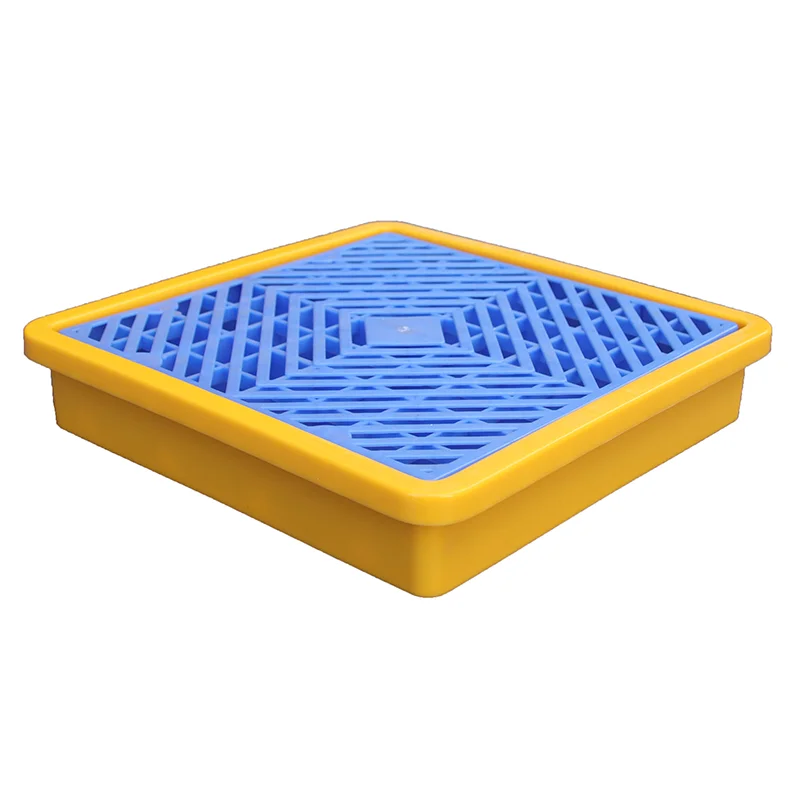
Spill Decks
- Overview: Spill decks are low-profile containment platforms designed for the safe storage of drums and smaller containers. They are ideal for facilities with space constraints, allowing for easy access to stored containers.
- 2 Drum and 4 Drum Variations: Spill decks are available in configurations to accommodate different numbers of drums, with 2 drum and 4 drum variants being the most common. The 2 drum decks are suitable for smaller storage needs, while the 4 drum decks offer larger containment capacity for facilities handling greater quantities of hazardous materials.
- Applications: Spill decks are widely used in manufacturing plants, laboratories, and workshops where the handling of chemicals and hazardous substances is routine. Their low profile makes them especially useful in areas with limited overhead space.
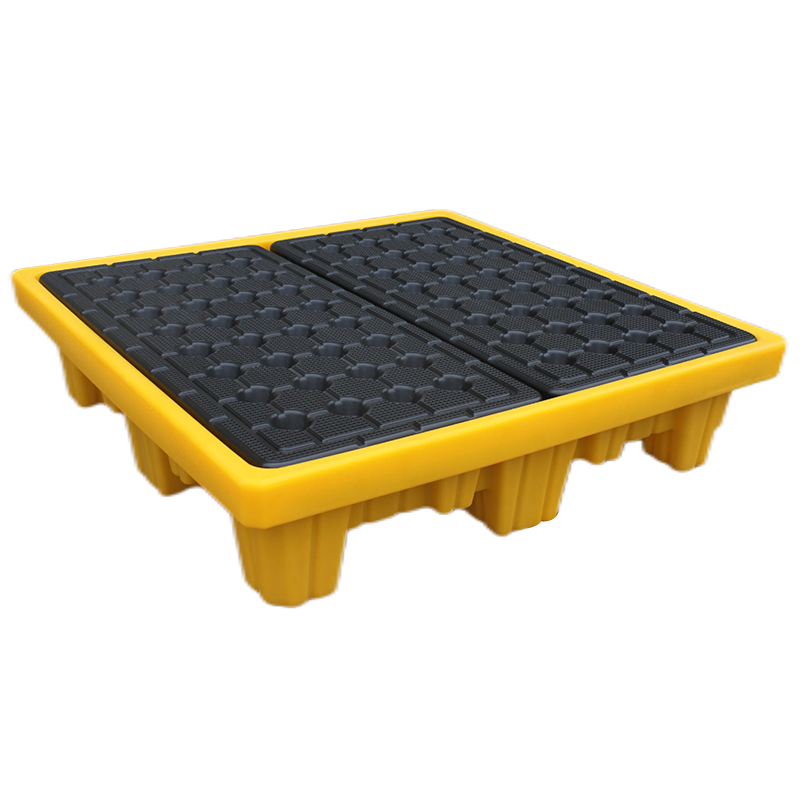
Spill Pallets
- Overview: Spill pallets are elevated containment platforms designed to hold one or more drums. They typically feature a grid or decking over the sump to support stored containers and allow spilled liquids to drain into the containment area.
- 2 Drum and 4 Drum Variations: Similar to spill decks, spill pallets come in 2 drum and 4 drum configurations to cater to different storage capacities. The choice between the two usually depends on the volume of hazardous materials a facility needs to store securely.
- Applications: These pallets are indispensable in sectors like agriculture, chemical manufacturing, and oil processing, where the risk of spillage is high. Their robust design ensures that spills are contained efficiently, preventing soil and water contamination.

IBC Spill Pallets
- Overview: IBC (Intermediate Bulk Container) spill pallets are designed to accommodate IBC totes, providing sturdy and secure containment for larger volumes of liquids. These pallets are essential for industries that utilize IBC totes for the storage and transportation of hazardous substances.
- Advantages: IBC spill pallets offer the benefit of high-capacity containment in a compact footprint, making them ideal for optimizing space in storage areas. They are typically constructed to withstand the heavy loads of IBC totes, ensuring durability and reliability in spill containment.
- Applications: These pallets find extensive use in the petrochemical sector, pharmaceutical manufacturing, and food and beverage industries, where large quantities of liquids are handled. Their ability to prevent environmental contamination and protect workplace safety makes them a critical component of operational risk management.
Choosing the correct type of spill containment pallet involves assessing the specific needs of your operations, including the volume of hazardous materials, space availability, and regulatory compliance requirements. Whether it’s a spill deck for low-profile storage, a spill pallet for versatile drum containment, or an IBC spill pallet for large-volume needs, each type offers distinct advantages to enhance safety and environmental protection in handling hazardous substances.
Material Considerations for Spill Containment Pallets
When it comes to spill containment pallets, the choice of material is crucial for ensuring chemical resistance, durability, and minimizing environmental impact. Among the materials used for these essential industrial tools, Linear Low-Density Polyethylene (LLDPE) and High-Density Polyethylene (HDPE) are particularly notable. Both materials offer unique properties through different manufacturing processes—rotational molding for LLDPE and injection molding for HDPE—with LLDPE-based pallets often recognized for superior quality.
LLDPE: Rotational Molding Excellence
LLDPE is favored for its exceptional flexibility, resistance to cracks, and durability. Rotational molding, the process used for LLDPE spill containment pallets, allows for uniform thickness and robust corner and edge designs. This manufacturing method enhances the spill pallet’s impact resistance and overall integrity, making it well-suited for harsh industrial environments. LLDPE pallets are especially effective in applications where flexibility and resistance to environmental stress cracking are critical.
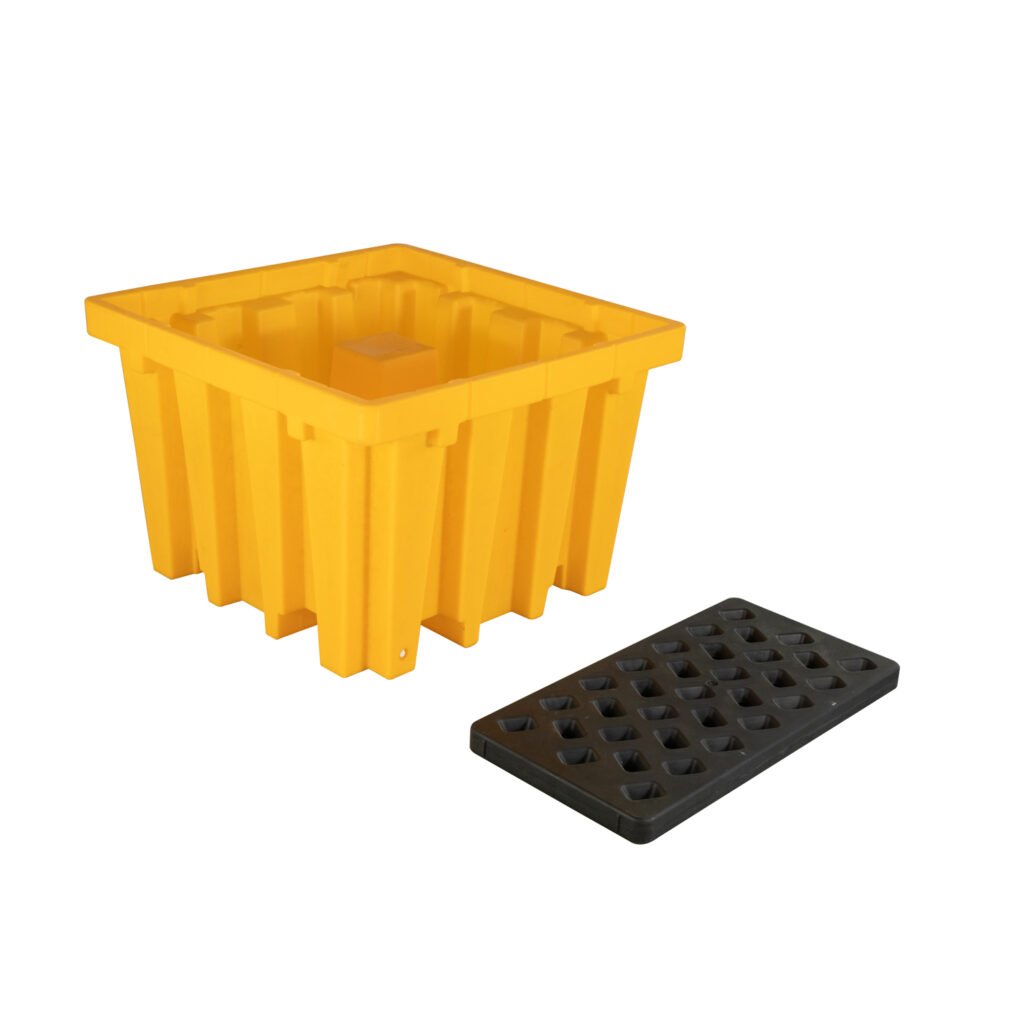
HDPE: Injection Molding Strength
HDPE, characterized by its rigidity and high tensile strength, is processed through injection molding. This method produces spill containment pallets that are strong and capable of bearing heavy loads, making them ideal for storing large containers or IBC totes. HDPE pallets are known for their chemical resistance, making them suitable for containing a wide range of substances without degrading. Their rigidity is beneficial in applications requiring stability and load support.
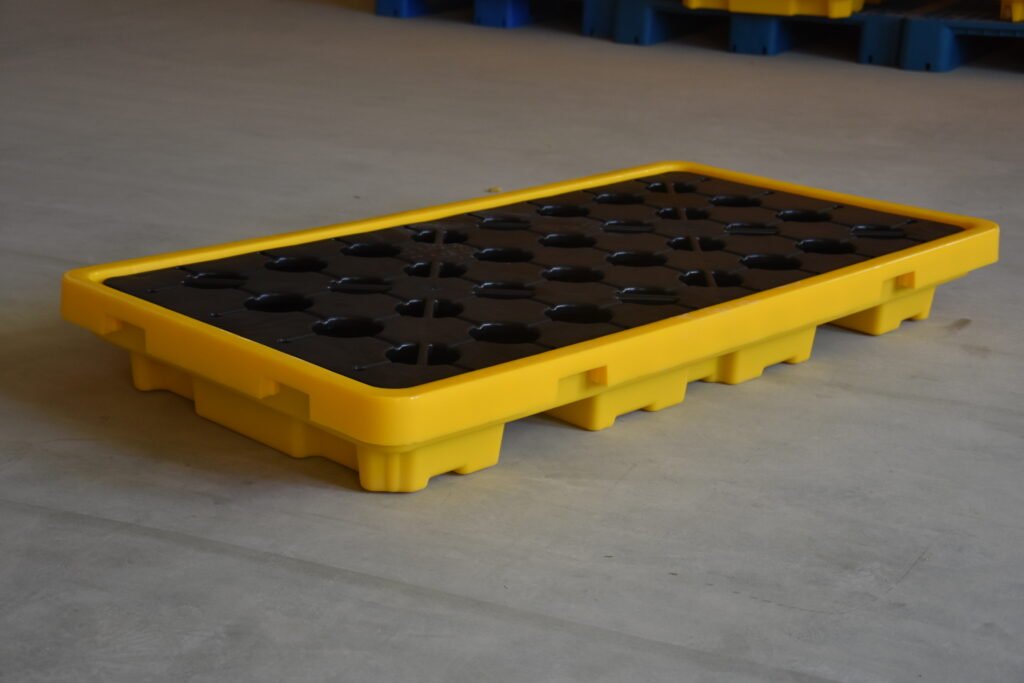
Environmental Impact
Both LLDPE and HDPE are recyclable, which contributes to reducing the environmental footprint of spill containment solutions. However, the longevity and lower maintenance requirements of these materials mean that pallets need to be replaced less frequently, further minimizing their environmental impact over time. Companies committed to sustainability often prefer polyethylene-based spill containment pallets for their balance of performance and recyclability.
Choosing the Right Material
The choice between LLDPE and HDPE for spill containment pallets often comes down to specific industrial needs and applications. LLDPE’s superior flexibility and impact resistance make it an excellent choice for dynamic or variable environments, while HDPE’s strength and chemical resistance are ideal for static, high-load applications. Both materials offer significant advantages in terms of durability and environmental sustainability, but LLDPE’s rotational molding process tends to produce spill containment pallets of higher quality and performance.
In summary, when selecting spill containment pallets, it’s essential to consider the specific characteristics and benefits of LLDPE and HDPE. Understanding the manufacturing processes and material properties can help businesses choose the most suitable spill containment solution for their needs, balancing effectiveness, durability, and environmental impact.
Applications Across Industries
Spill containment pallets are critical across various industries for managing hazardous spills, enhancing workplace safety, and ensuring environmental protection. Below are insights into how these spill containment solutions are applied in sectors like the petrochemical industry and laboratories, highlighting their versatility and effectiveness.
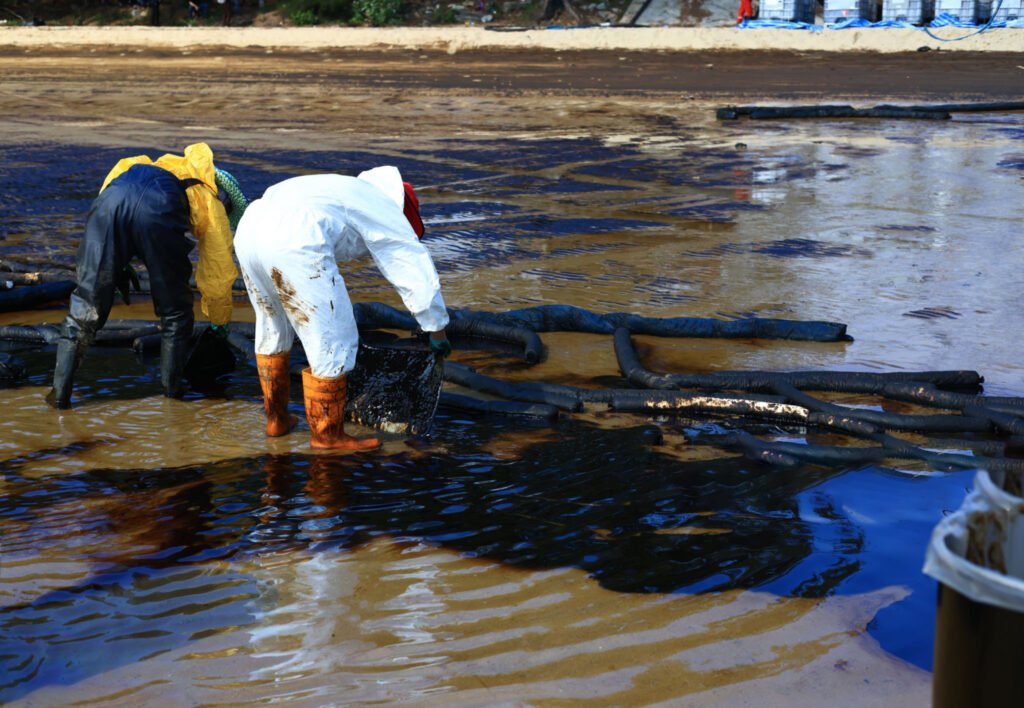
Petrochemical Industry
In the petrochemical sector, handling and storing chemicals and oil products pose significant spill risks. Spill containment pallets are extensively used to manage these risks efficiently. For instance, a petrochemical facility may use HDPE spill containment pallets for storing barrels of crude oil or chemical reagents. The chemical resistance of HDPE ensures that the pallets can withstand aggressive substances, while their durable design prevents leaks from reaching the ground, safeguarding soil and water sources from contamination.
A notable application can be seen in refineries where bulk containers of lubricants and fuels are stored on large spill containment platforms. These platforms not only contain spills but also facilitate easy cleanup, thereby maintaining operational continuity and compliance with environmental regulations.
Laboratories
Laboratories handle various chemicals, some of which are highly volatile or reactive. Spill containment pallets, particularly those made from LLDPE due to their chemical resistance and flexibility, are crucial in these settings. They provide a secure environment for storing chemical containers, minimizing the risk of spill-related accidents.
An example of effective spill containment in a laboratory setting could involve the use of spill decks beneath storage racks. These decks catch and contain accidental drips during the transfer of chemicals from one container to another, ensuring the safety of laboratory personnel and preventing chemical exposure.
Other Industries
Beyond petrochemicals and laboratories, spill containment pallets find applications in:
- Agriculture: For storing pesticides and fertilizers safely.
- Manufacturing: Where they contain spills from machinery or during the production process.
- Transportation and Logistics: Used at loading docks or in transportation vehicles to contain leaks from transported goods, especially hazardous materials.
Case Study: Effective Spill Containment in Action
A chemical manufacturing plant once faced frequent spill incidents, leading to operational disruptions and potential environmental fines. By implementing a system of IBC spill containment pallets designed for high-capacity storage, the facility managed to significantly reduce spill incidents. These pallets, chosen for their durability and chemical resistance, enabled the plant to safely store large quantities of various chemicals. As a result, the company not only improved its compliance with safety regulations but also enhanced its operational efficiency by minimizing cleanup times and avoiding product losses.
These examples underscore the importance of spill containment pallets in maintaining safety and environmental standards across industries. By choosing the appropriate type and material of spill containment solutions, businesses can protect their employees, the environment, and their bottom line from the potentially devastating effects of spills.
Selecting the Right Spill Containment Pallet
Factors to Consider
Capacity
Select a pallet that can handle the volume of the largest spill you could reasonably anticipate. This ensures complete containment and prevents overflow incidents.
Compatibility with Stored Materials
Ensure the pallet material is compatible with the chemicals or substances you’re storing. This is critical for preventing material degradation that could lead to leaks.
Regulatory Compliance
Choose pallets that meet all relevant environmental and safety regulations for your industry. Compliance helps avoid fines and ensures the safety of your operations and the environment.

Matching Solutions to Industry Requirements
AquaPure – Water Treatment Company
AquaPure needs spill containment for various chemicals used in water treatment processes. They choose Enlightening Pallet’s HDPE spill containment pallets because of their high chemical resistance and durability. These pallets’ high capacity and compliance with EPA regulations make them ideal for AquaPure’s extensive chemical storage needs, ensuring safe and compliant operations.
ChemSecure – Chemical Manufacturing
ChemSecure manufactures a wide range of industrial chemicals, requiring robust spill management solutions. They opt for Enlightening Pallet’s polyethylene spill containment pallets, specifically designed for chemical compatibility. The modular design allows ChemSecure to customize their spill containment areas according to the specific chemicals handled, ensuring safety and regulatory compliance across their operations.
GrainCorp – Agricultural Supply Company
GrainCorp stores large quantities of pesticides and fertilizers, substances that are hazardous to the environment if spilled. They select Enlightening Pallet’s LLDPE spill decks, which offer excellent chemical resistance and are easy to clean and maintain. The decks’ capacity to withstand the outdoor storage conditions and their compliance with agricultural industry regulations make them a perfect fit for GrainCorp.
Conclusion
When selecting the right spill containment pallet for your company, consider Enlightening Pallet for solutions that meet your specific industry requirements. With a focus on capacity, compatibility, and compliance, Enlightening Pallet provides a range of spill containment options suitable for various sectors, ensuring safety, environmental protection, and regulatory adherence. By evaluating these key factors, companies like AquaPure, ChemSecure, and GrainCorp can make informed decisions that bolster their spill management strategies with quality solutions from Enlightening Pallet.
Maintenance and Regulations for Spill Containment Pallets
Proper maintenance and understanding regulatory standards are crucial for the effectiveness and longevity of spill containment solutions like Modular PE Spill Pallets. Ensuring compliance with spill prevention and control regulations not only protects the environment but also shields businesses from potential legal issues.
Maintenance Guidelines
Routine Inspections: Regular checks for damage or wear and tear are essential. Inspect for cracks, warping, or signs of chemical degradation, especially in high-contact areas.
Cleaning Procedures: Modular PE Spill Pallets and similar containment units should be cleaned regularly to remove any chemical residues or contaminants. Use appropriate cleaning agents that do not react with the pallet material. For Hard Top Spill Pallet factories and other facilities, establishing a cleaning schedule that aligns with the frequency of use and the types of substances handled is crucial.
Replacement and Repair: Any damaged components should be repaired or replaced promptly to maintain the integrity of the containment system. This includes fixing leaks, replacing seals, and ensuring covers fit securely.
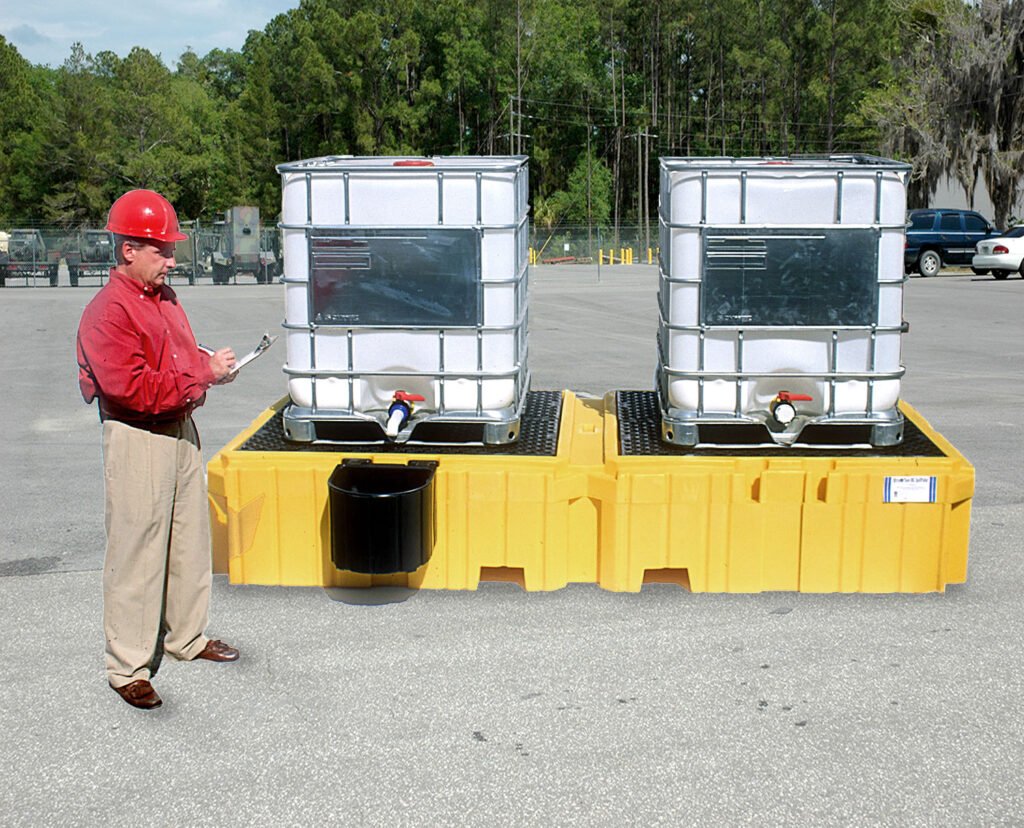
Regulatory Standards and Compliance
Spill Prevention, Control, and Countermeasure (SPCC): The U.S. Environmental Protection Agency (EPA) requires facilities that store large quantities of petroleum and other hazardous substances to have an SPCC plan in place. This includes using spill containment pallets to prevent oil spills from reaching navigable waters.
Resource Conservation and Recovery Act (RCRA): Facilities handling hazardous waste must comply with RCRA standards, which may involve using containment solutions to prevent leaks and spills from hazardous waste containers.
Occupational Safety and Health Administration (OSHA): OSHA regulations require secondary containment for certain chemicals in the workplace to protect workers from exposure. Facilities must ensure their spill containment systems meet OSHA’s standards for health and safety.
Local and State Regulations: Beyond federal laws, businesses should be aware of any additional local or state requirements for spill containment and environmental protection. These can vary significantly and may impose stricter controls or additional reporting requirements.
Conclusion
For businesses utilizing Modular PE Spill Pallets or any spill containment systems, regular maintenance and compliance with regulatory standards are key to ensuring operational safety and environmental protection. By conducting routine inspections, adhering to cleaning and maintenance protocols, and staying informed about the relevant regulations, companies can effectively manage their spill containment needs while fulfilling their legal obligations. Manufacturers like Hard Top Spill Pallet factories play a crucial role in providing compliant containment solutions that meet industry requirements, supporting businesses in their spill prevention and control efforts.
Navigating the Market: Choosing the Right Supplier
hen navigating the market for spill containment pallet suppliers, it’s essential to focus on several critical areas to ensure you’re choosing a partner that aligns with your operational needs and values. Here’s a guide on selecting the right supplier, emphasizing product quality, sustainability practices, and customer support.
Criteria for Selecting a Supplier
Product Quality
- Material Durability: Ensure the supplier’s products are made from high-quality materials that offer chemical resistance and durability for long-term use.
- Design Efficiency: Look for innovative design features that enhance spill containment, such as modular configurations or integrated drainage systems.
Sustainability Practices
- Eco-friendly Materials: Choose suppliers that utilize recycled materials or offer eco-friendly alternatives for their products.
- Sustainability Certifications: Check if the supplier has any environmental certifications, such as ISO 14001, which demonstrates a commitment to environmental management.
Customer Support
- Expert Advice: A good supplier should have knowledgeable staff who can provide expert recommendations based on your specific needs.
- After-sales Service: Look for suppliers who offer robust after-sales support, including product warranties, maintenance tips, and repair services.
Questions to Ask Suppliers
- Can you provide detailed information on the materials used in your spill containment pallets?
- This question helps assess the durability and chemical compatibility of their products.
- What sustainability practices do you implement in your manufacturing and supply chain?
- This will give you insight into their commitment to environmental stewardship.
- How do your products comply with regulatory standards for spill containment?
- A reputable supplier should be up-to-date with industry regulations and ensure their products meet or exceed these standards.
- Can you share case studies or testimonials from businesses similar to ours?
- Real-world examples can provide a clearer picture of how their solutions perform in scenarios similar to your operations.
- What post-purchase support do you offer?
- Understanding the level of support provided after the sale can be crucial, especially for products that play a critical role in safety and compliance.
By carefully considering these criteria and asking targeted questions, you can confidently navigate the market and select a spill containment pallet supplier that meets your needs. A partnership with the right supplier not only enhances your spill containment strategy but also supports your overall commitment to safety, environmental protection, and regulatory compliance.
Spill containment pallets play a pivotal role in promoting industrial safety and protecting the environment from potential hazards. Their importance in efficiently managing and containing spills of hazardous materials cannot be overstressed. These containment solutions are essential components of a comprehensive risk management strategy, ensuring that businesses not only comply with regulatory standards but also safeguard their operations, workforce, and the surrounding ecosystem from the adverse effects of uncontrolled spills.
Conclusion
The integration of spill containment pallets into operational practices highlights a proactive approach to environmental stewardship and workplace safety. Businesses across various sectors—ranging from chemical manufacturing to agriculture, and laboratories to petrochemical industries—can significantly benefit from the implementation of these spill containment solutions. By choosing the right type of containment pallet, considering factors such as capacity, compatibility with stored materials, and adherence to regulatory compliance, companies can effectively mitigate the risks associated with handling hazardous substances.
It’s imperative for businesses to not only recognize the critical role of spill containment pallets in their operations but also to act proactively by incorporating these solutions into their risk management plans. Engaging with reputable suppliers who emphasize product quality, sustainability practices, and customer support further enhances the effectiveness of spill containment strategies. In doing so, businesses can demonstrate their commitment to safety and environmental protection, fostering a culture of responsibility and resilience.
As industries continue to evolve and face new challenges, the need for reliable spill containment solutions remains constant. Companies are encouraged to stay informed about the latest advancements in spill containment technologies and best practices, ensuring they are well-equipped to manage potential spills effectively. Through proactive implementation and ongoing diligence, businesses can maintain the highest standards of safety and environmental protection, contributing to a safer and more sustainable future.

